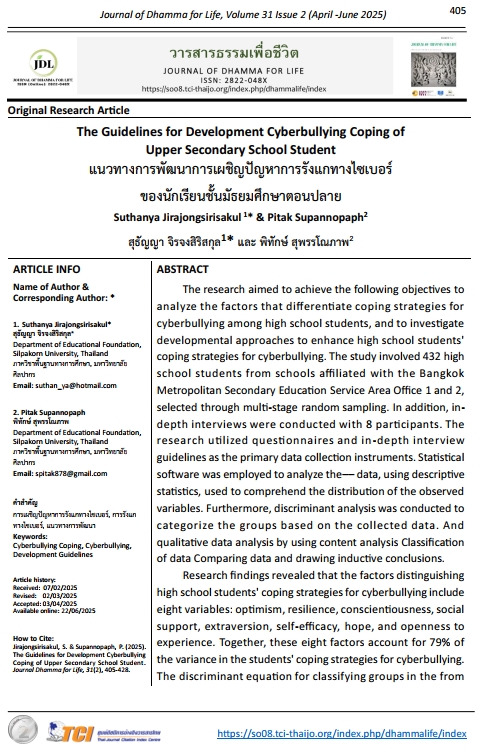The Guidelines for Development Cyberbullying Coping of Upper Secondary School Student
Main Article Content
Abstract
The research aimed to achieve the following objectives to analyze the factors that differentiate coping strategies for cyberbullying among high school students, and to investigate developmental approaches to enhance high school students' coping strategies for cyberbullying. The study involved 432 high school students from schools affiliated with the Bangkok Metropolitan Secondary Education Service Area Office 1 and 2, selected through multi-stage random sampling. In addition, in-depth interviews were conducted with 8 participants. The research utilized questionnaires and in-depth interview guidelines as the primary data collection instruments. Statistical software was employed to analyze the–– data, using descriptive statistics, used to comprehend the distribution of the observed variables. Furthermore, discriminant analysis was conducted to categorize the groups based on the collected data. And qualitative data analysis by using content analysis Classification of data Comparing data and drawing inductive conclusions.
Research findings revealed that the factors distinguishing high school students' coping strategies for cyberbullying include eight variables: optimism, resilience, conscientiousness, social support, extraversion, self-efficacy, hope, and openness to experience. Together, these eight factors account for 79% of the variance in the students' coping strategies for cyberbullying. The discriminant equation for classifying groups in the from standardized scores is: Z y = .603(OPT) + .461(FLE) - .380(CON) + .306 (SOC) +.240(EXT) + .235(BEL) + .215(EXP) + .202(OPE)
And the guidelines for development cyberbullying coping of upper secondary school student are found to have 7 approaches. These include: 1) Integrating problem-solving knowledge with media and technology in learning. 2) promoting awareness, critical thinking, and life skills development. 3) Encouraging the development of desirable characteristics through learning. 4) Organizing activities that promote creative self-expression and confidence. 5) Promoting public consciousness and teamwork. 6) Creating a supportive learning environment. 7) Encouraging parental involvement in guiding students to cope effectively with cyberbullying.


